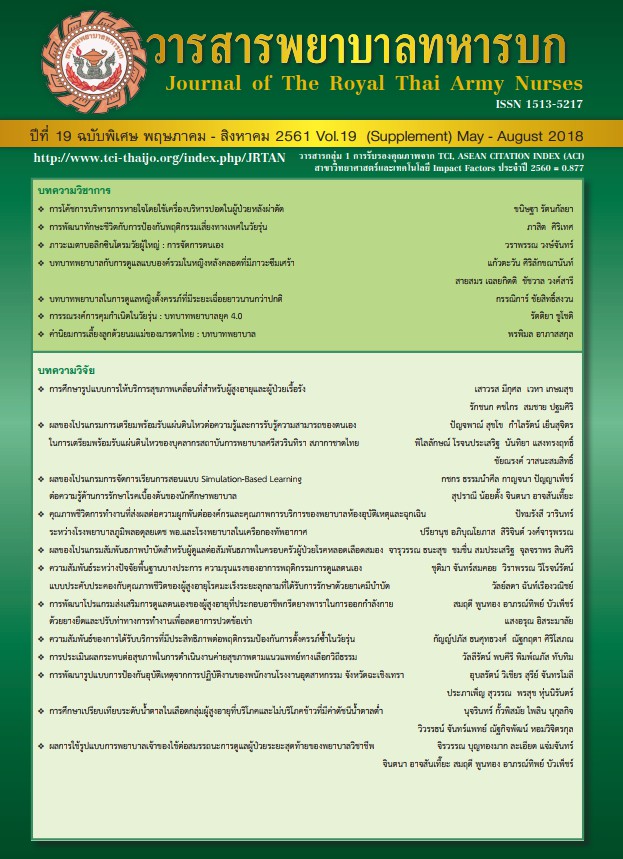Instrument Development for Measuring Quality of Medication Safety Management in Hospitals
Keywords:
Medication safety management, Hospital, Medical error, Instrument developmentAbstract
This study aims to generate scale items for the measurement of quality medication safety management in hospitals and to verify the scale in terms of validity and reliability. The development and evaluation process was based on the scale development guidelines by DeVellis. The literature review and interviews with five experts provided a framework for item formulation. Another five experts evaluated the content validity of the instrument. 481 registered nurses completed the questions in the instrument, and the data from the registered nurses were then analyzed to evaluate the construct validity using factor analysis and to test for reliability indexes. The results revealed that there were 48 items constituting the scale whereby to measure the quality of medication safety management in hospitals. The items were grouped into six components of medication safety management: drug prescription, drug dispensing, drug administration, high-alert drug management, medical error management, proactive drug safety management. The data on reliability supported a good internal consistency (Cronbach alpha coefficient was .83). The construct validity was confirmed by a six component model of medication safety management as a good measure of quality in medical safety management (RMSEA < .048, χ2/d.f. =1.73, NFI= .899, CFI = .98, PNFI = .91).
Downloads
References
Health Product Vigilance Center. Spontaneous reports of adverse drug reactions. Nontaburi; Food and Drug Administration. 2017. (In Thai)
World Health Organization. Reporting and learning systems for medication errors: the role of pharmacovigilance centers. Geneva: World
Health Organization. 2014.
European Medicines Agency. Good practice guide on risk minimization and prevention of medication errors. London: European Medicines Agency. 2015.
The Healthcare Accreditation institute. Hospital and healthcare standards. 4th ed. Nontaburi: D-one books. 2018. (In Thai)
Phoksiri M, Pakdeewong P, Wannapornsiri C. A development of knowledge management model of high alert drug administration for head nurses in hospitals under Royal Thai Army. Journal of The Royal Thai Army Nurses. 2014;15(1): 81-9. (In Thai)
Chaichanawirote U, Kongkaew C. The study of communication social networks in medical usage among health care providers by using a social network analysis. Journal of The Royal Thai Army Nurses. 2016;17(3): 107-14. (In Thai)
Gonzales KJ. Assessments of safe medication administration in nursing education. Journal of Nursing Education and Practice. 2011; 2(1): 39-50.
Armutlu M, Foley ML, Surette J, Belzile E, Mc-Cusker J. Survey of nursing perceptions of medication administration practices, perceived sources of errors and reporting behaviors. Healthcare Quarterly. 2008;11 (3 Spec No): 59-65.
DeVellis RF. Scale development: theory and applications. 3rd ed. Thousand Oaks, CA: Sage Publications. 2012.
Gorsuch R. Factor analysis. New York: Taylor & Francis Group. 2015.
Polit DF, Beck CT. The content validity index: are you sure you know what’s being reported? Critique and recommendations. Research in Nursing & Health. 2006;29(5): 489-97.
Van Gelderen SC, Zegers M, Boeijen W, Westert GP, Robben PB, Wollersheim HC. Evaluation of the organisation and effectiveness of internal audits to govern patient safety in hospitals: a mixed-methods study. BMJ open. 2017;7(7): 1-10.
Thaveechai V, Jun-eam W. Data management for hospital accreditation of university hospitals. Nursing Journal. 2016;43(3): 102-116.
Wagner C, Merten H, Zwaan L, Lubberding S, Timmermans D, Smits M. Unit-based incident reporting and root cause analysis: variation at three hospital unit types. BMJ open. 2016;6(6): 1-8.
Rohmani N, Marisa K. Nurses’ adherence to medication administration practice at Indonesian Public Hospitals. Journal of Nursing and Health Care. 2016;34(3): 162-167.
Page N, Baysari M, Westbrook J. A systematic review of the effectiveness of interruptive medication prescribing alerts in hospital CPOE systems to change prescriber behavior and improve patient safety. International Journal of Medical Informatics. 2017;105: 22-30.
Chanatepaporn P. Development of high-alert drug monitoring system in Srinagarind Hospital. Srinagarind Medical Journal. 2015;30(1): 46-56.
Pham JC, Girard T, Pronovost PJ. What to do with healthcare incident reporting systems. Journal of Public Health Research. 2013; 2(3): 1-6.
Magalhães GF, de Carvalho Santos GBN, Rosa MB, Noblat LdACB. Medication reconciliation in patients hospitalized in a cardiology unit. PloS one. 2014;9(12): 1-12.
Ciociano N, Bagnasco L. Look alike/sound alike drugs: a literature review on causes and solutions. International Journal of Clinical Pharmacy. 2014;36(2): 233-242.
Downloads
Published
How to Cite
Issue
Section
License
บทความหรือข้อคิดเห็นใดใดที่ปรากฏในวารสารพยาบาลทหารบกเป็นวรรณกรรมของผู้เขียน ซึ่งบรรณาธิการหรือสมาคมพยาบาลทหารบก ไม่จำเป็นต้องเห็นด้วย
บทความที่ได้รับการตีพิมพ์เป็นลิขสิทธิ์ของวารสารพยาบาลทหารบก
The ideas and opinions expressed in the Journal of The Royal Thai Army Nurses are those of the authors and not necessarily those
of the editor or Royal Thai Army Nurses Association.






